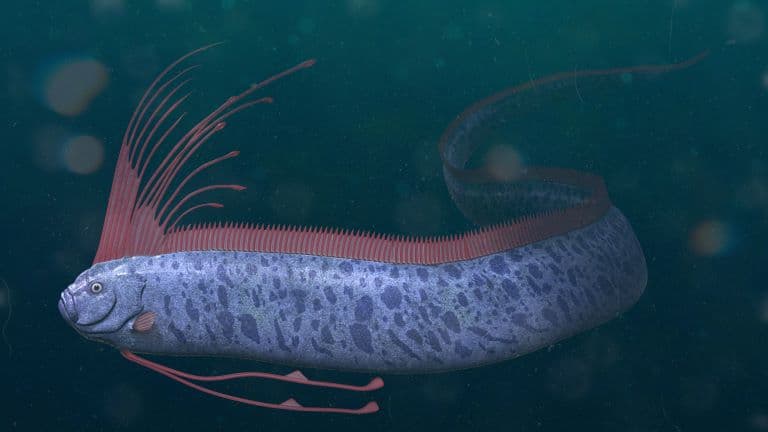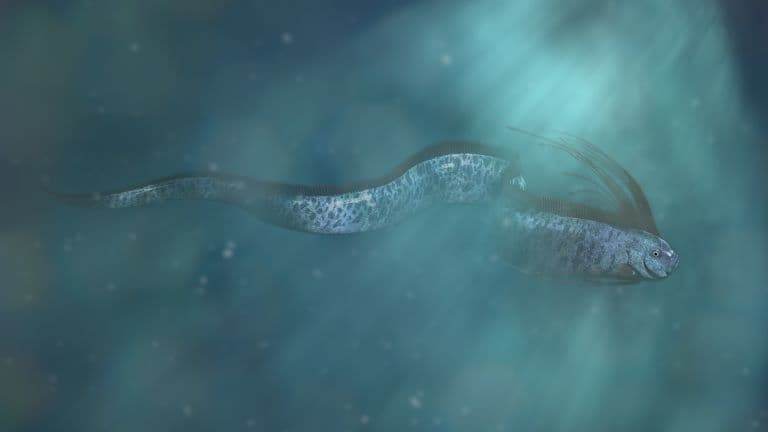Giant Oarfish Profile
The largest ecosystems on Earth exist below 200 meters under the ocean. And we’re putting substantially more money into destroying them than exploring them. Even today, these are some of the least-understood places on the planet, yet there are so many treasures yet to be discovered.
One such treasure is the giant oarfish, a creature so weird and mysterious that it’s still mostly known to legend.

Giant Oarfish Facts Overview
| Habitat: | Deep, tropical to temperate waters |
| Location: | Worldwide |
| Lifespan: | Unknown |
| Size: | Confirmed 8m (26 ft) long, possibly up to 11 m (36 ft) |
| Weight: | 270 kg (600 lb) |
| Colour: | Silvery-grey with blue streaks, red bands, or other colours present. |
| Diet: | Zooplankton, jellyfish, shrimp |
| Predators: | Likely sharks, sperm whales, other large predators |
| Top Speed: | Unknown |
| No. of Species: | 1 |
| Conservation Status: | Least Concern (IUCN) |
Oarfish are members of the Lampriformes order, a group of very flat, very shiny and brightly-coloured bony fish. And they don’t disappoint. These are some of the flattest, most shiny and brightly coloured of them all, and certainly the longest.
Giant oarfish are mysterious creatures with long appendages on their heads and a habit of drifting, vertically suspended in the water, looking eerie. Yet, very few have ever witnessed this, and what little we know about them has been gleaned from dead or dying specimens, artificial insemination and a parasite assay.
Interesting Giant Oarfish Facts
1. King of Herrings
This fish unsurprisingly has a lot of names, one of which is the “King of herrings”, which may have come from the adornments seen on the head of the animal, and the fact that herrings are so popular among the Nords, who found the type specimen in Norway.
Fishermen once thought that the oarfish would guide herring, and claimed that they were sighted near large shoals.
They’re also exceptionally shiny and vibrantly coloured fish, giving them an air of regality, at least y fish standards.
2. They’re long!
Another thing that makes these fish exceptional is just how long they are, and this likely has more to do with their other common name: oarfish.
This length is as variable as the imagination of fishermen, but confirmed measurements of 8 meters make it the longest teleost (bony fish) in the ocean. More commonly, they’re found to be 3-5m long, but 16m specimens have been reported.
They’re ribbon-like, shimmering flakes of fish with a sort of serpentine wiggle that may have spawned legends. 1

3. They might be sea serpents
The oarfish spends most of its time in the deep, and we know very little about it. Size measurements typically come from washed-up dead ’uns which may have changed shape or size on their uncomfortable ascent to the surface or from drying out on the beach.
But they have been sighted at sea for hundreds of years, and it’s thought that their snake-like swimming style could have been the origin of sea serpent tales of old.
While they’re mostly witnessed dead or dying, an ironic opportunity for wildlife observation comes from the petrochemical industry, where remote man-made islands are set up to drill for oil.
These industries deploy rovers to scout about the place, and sometimes come back with exceptional underwater footage of beasts from the depths, allowing us to see exactly what kind of wildlife we’re destroying down there.
The first such footage of the oarfish came about this way, in the Gulf of Mexico, and it shows a far brighter animal than we’re used to seeing on land. Their incredible colouration fades upon death, but there are some suggestions that while they’re alive, they’re not only brightly-coloured but also bioluminescent. 2 3
4. They’re prone to strandings
Other footage of these fish comes from cases of strandings, where adults will swim into the shallows and often onto land to die. Whether they do this on purpose or as a result of disorientation is unclear, but they’re clearly not healthy examples.
It’s yet unknown why they do it at all. Some rumour that they do it before earthquakes, but this seems very dubious.
5. They can drop their tails
While we know very little about the species, one thing that’s come to light is the apparent ability of this fish to disconnect its tail.
Like some other long wiggly animals, self-amputation, or autonomy, might be a predator escape solution, and is likely a good way to escape a shark. This is not something that’s commonly seen in fish, and unfortunately for the oarfish, it looks like it doesn’t grow back.
6. They glow in the dark
When filmed underwater, this fish appears to hang vertically, with their heads up, and just rhythmically rippling to stay in place. It’s thought this is how they feed, and they may make use of photophores to either communicate or attract prey while here.
Fortunately for the fish, they aren’t tasty to people, and their depth tends to keep them out of reach of most fishing boats, though they are sometimes brought up as by-catch.

7. They could be electric
At least one report suggests that the fish gives off an electrical impulse when touched, which would make it an even more interesting animal, but there’s nothing more than a single person’s word to go on with this, so we really need to get out there and touch more of them to find out.
8. They’ve been bred in captivity
The nature of breeding in such an elusive animal is always going to be hard to pin down, but researchers were able to rescue the testicles of a stranded fish and use them to inseminate a captive one, just to see what happens.
After 18 days of development, oarfish larvae hatched, looking similar to other larvae in the family. They swam around with their heads down, opening their mouths a bit, but unfortunately, they didn’t eat and died within four days.
From this morbid experiment, scientists devised that this is likely a batch spawning fish, producing a huge number of buoyant eggs every breeding season. 4
9. Sperm whales might eat them
Another inference was formed using the parasite load of captured oarfish. Just like on land, the ocean has tapeworms and other lovely penetrators living in complex life cycles using multiple hosts.
It appears that the oarfish might be the intermediate host of a tapeworm and some nematodes commonly found in mako sharks and sperm whales, which therefore suggests the two large predators might be their primary predators. 5
Giant Oarfish Fact-File Summary
Scientific Classification
| Kingdom: | Animalia |
| Phylum: | Chordata |
| Class: | Actinopterygii |
| Order: | Lampriformes |
| Family: | Regalecidae |
| Genus: | Regalecus |
| Species: | glesne |
Fact Sources & References
- Craig R. McClain, (2015), “Sizing ocean giants: patterns of intraspecific size variation in marine megafauna”, PubMed Central.
- Benfield, M. C (2013), “Five in situ observations of live oarfish Regalecus glesne (Regalecidae) by remotely operated vehicles in the oceanic waters of the northern Gulf of Mexico”, Sci Hub.
- Jody Bourton (2010), “Giant bizarre deep sea fish filmed in Gulf of Mexico”, Earth News.
- Zoological Lett (2020), “First observation of larval oarfish, Regalecus russelii, from fertilized eggs through hatching, following artificial insemination in captivity”, NIH.
- Armand M. Kuris (2015), “Monsters of the Sea Serpent: Parasites of an Oarfish, Regalecus russellii”, BioOne Digital Library.
